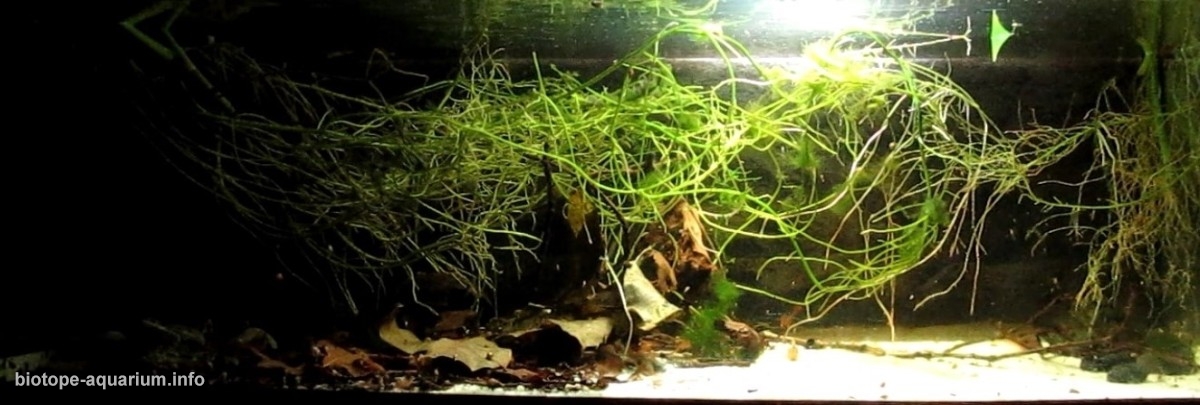Corydoras in Los Tres Gigantes, Rio Negro National Park, Paraguay
127th place in Biotope Aquarium Design Contest 2019
Austria. Uwe Zufelde

Volume: 160 L
Dimensions: 100x40x40 cm
List of fishes: Corydoras paleatus, Corydoras aeneus
List of plants: Roots, hair alge
Description of decorations: My aquarium has no water plants. Soil consists of beige sand and fine gravel (0.1 to 1mm). Height between 5 and 8cm. Rounded larger river pebbles, driftwood. Foliage. Durability of foliage or food: Oak leaves (Quercus) 8 months and more (deco). Walnut leaves (Juglans regia) 10 to 14 days (food). European beech (Fagus sylvatica L.) 2 months (deco / food). Teak leaf (Tectona grandis) 1 month (deco / food). Guava leaf (Psidium guajava) so far 2 months (deco). Willow branches (Salix matsudana) 8 months and more partially alive Moringa oleifera fallen leaves (chopped) 2 days (food).
Description of equipment: Filter: Hamburger Matten Filter (sponge 10Bx10Tx35H cm). Flow: Eheim compact pump 300l/h. Lighting: DEHNER Nano Amazon Day, 6000 Kelvin, 900 Lumen, 10h to 22h. Heating: No. Room heating depending on the season between 21 and 25 degrees. Plexiglas cover right and left about 10cm open.
Water parameters: PH 8, GH 11,7, KH 11,4, Nitrite 0
Additional info: My biotope shows a section of a tributary of the Negro River in the Rio Negro National Park (RNNP) near the beginning of the dry season (July) Los Tres Gigantes – Estacion Biologica (former military station from the Chaco War). Water level about 35cm, with a water exchange = flow to a small extent still takes place. Foliage, branches and incipient green algae, give newly hatched armored catfish of the genus Corydoras aeneus microorganisms and cover. Some accompanying on previous wandering Corydoras paleatus together form a peaceful squad. Living roots of unknown origin give the animals more security, depending on the time of day, shadows are donated by adjacent Carapa guianensis. Leaves of the same Andiroba, are also found in the water.
INFORMATION ABOUT BIOTOPE
Description of the area surrounding the biotope: The Rio Negro National Park (RNNP) was created by decree of the Power Executive No. 14.218 in 2004, with an area of 123,786. The incorporation of the 14,000 hectare Paraguayan Pantanal Reserve / Tres Gigantes biological station, owned and managed by the Guyra Paraguay Association, is planned. Both areas constitute a mosaic of conservation and biological corridor recognized as Ramsar site, as well as an important bird area (IBA), which is part of the Chaco Biosphere Reserve, as one of several core zones. Annual regular floods of the Gran Pantanal cycles give the National Park Rio Negro a unique feature.This area offers a majestic combination of palm trees (mainly of Copernicia alba, savannah, during a period for which their flora adapted to the dry environments such as is flooded), river forests and forests of Quebracho colorado (Schinopsis balansae) that accompany the Paraguay River and the Negro River. This can be seen in connection with the own wetland vegetation (dammed up), in addition to lagoons and sandbanks, which together exert a unique attraction on the area.
Description of the underwater landscape of the biotope: –
Description of the parameters of the habitat: Coordinates: 19° 52′ 22″ S, 58° 31′ 14″ W. 21 bis 25 degrees
List of fishes and invertebrates occurring in the nature biotope: Corydoras paleatus, Corydoras aeneus, Paracheirodon axelrodi, Carnegiella strigata
List of plants found in the nature biotope: Water: Chloroplastida. Land: Carapa guianensis, Hymenaea courbaril L.
Threats to the ecology: The fragility of the Pantanal is high and the effects of human practices (dredging, excessive fishing, deforestation, acute erosion, sewage, waste, dams causing hydrodynamic changes, sewerage of watercourses) pose a serious threat to the entire region. The Pantanal National Park and the Dorochê Reserve are directly affected by negative human activity. The Acurizal and Penha reserves are less affected by these impacts, but their floodplains are affected by these impacts.
Sources of information:
https://whc.unesco.org/en/
Coordinates: 19° 52′ 22″ S, 58° 31′ 14″ W
Mr. Erik Schiller answered my questions by mail.
https://www.tripadvisor.at/
